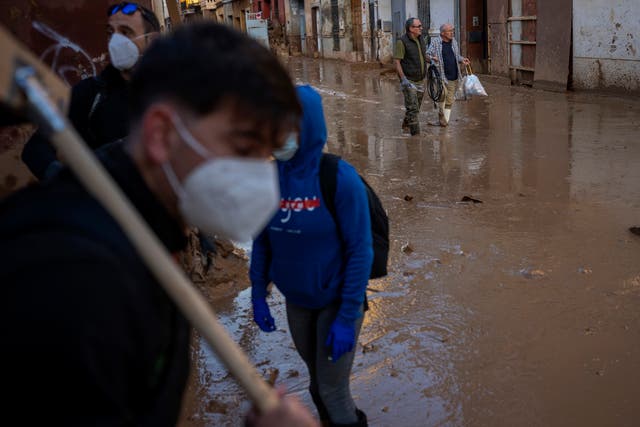
A Spanish research vessel that investigates marine ecosystems has been deployed to search for people missing after catastrophic flooding.
The 24 crew members aboard the Ramon Margalef will use its sensors and submergible robot to map an offshore area of 36 square kilometres – the equivalent of more than 5,000 football fields —- to see if they can locate vehicles that last week’s floods swept into the Mediterranean Sea.
The hope is that a map of sunken vehicles could lead to the recovery of bodies. Nearly a hundred people have been officially declared missing, and authorities admit it is likely there are more people unaccounted for in addition to the more than 200 declared dead.
Pablo Carrera, the marine biologist leading the mission, estimates that in 10 days his team will be able to hand over useful information to police and emergency services.

Without a map, he said it would be practically impossible for police to carry out an effective and systematic recovery operation to reach vehicles that ended up on the seabed.
“It would be like finding a needle in a haystack,” Mr Carrera said.
Many cars became death traps when the tsunami-like flooding hit on October 29.
The boat will join a wider effort by police and soldiers who have expanded their searches for bodies and the missing beyond the devastated towns and streets.
Searchers have used poles to probe into layers of mud while sniffer dogs tried to find scent traces of bodies buried in canal banks and fields. They are also looking at beaches that line the coast.
The first area the Ramon Margalef is searching is the stretch of sea off the Albufera wetlands, where at least some of the water ended up after ripping through villages and the southern outskirts of Valencia city.
Spanish state broadcaster said on Friday that the body of one woman had been found on the beach after she went missing when the rushing water swept through her town of Pedralba, roughly an hour’s drive from the coast.
Mr Carrera, 60, is head of the fleet of the research vessels run by the Spanish Institute of Oceanography, a government-funded science centre under the umbrella of the Spanish National Research Council.
He boarded the Ramon Margalef in Alicante, located down Spain’s coast, from where it will set sail to reach Valencia’s waters before dawn on Saturday.
The plan is to go straight to work with the 10 scientists and technicians and 14 sailors working non-stop in shifts. The boat also helped research the impact from the lava flow that reached the sea from the 2021 La Palma volcano eruption in Spain’s Canary Islands.
Finding a body at sea is highly unlikely, so the focus is on large objects that should not be there.
The boat’s submergible robot loaded with cameras can dive to a depth of 60 meters to attempt to identify cars. Ideally, they will try to locate licence plates, although visibility could be extremely limited and the cars could be smashed to bits or engulfed in the mud, Mr Carrera said.
In the longer term, he said his team will also evaluate the impact of the flood run-off on the marine ecosystem.
Spain’s meteorological agency said that the 30.4 inches of rain that fell in one hour in the Valencian town of Turis is an all-time national record.
“We have never seen an autumn storm of this intensity,” Mr Carrera said. “We cannot stop climate change, so we have to prepare for its effects.”


Why are you making commenting on The Herald only available to subscribers?
It should have been a safe space for informed debate, somewhere for readers to discuss issues around the biggest stories of the day, but all too often the below the line comments on most websites have become bogged down by off-topic discussions and abuse.
heraldscotland.com is tackling this problem by allowing only subscribers to comment.
We are doing this to improve the experience for our loyal readers and we believe it will reduce the ability of trolls and troublemakers, who occasionally find their way onto our site, to abuse our journalists and readers. We also hope it will help the comments section fulfil its promise as a part of Scotland's conversation with itself.
We are lucky at The Herald. We are read by an informed, educated readership who can add their knowledge and insights to our stories.
That is invaluable.
We are making the subscriber-only change to support our valued readers, who tell us they don't want the site cluttered up with irrelevant comments, untruths and abuse.
In the past, the journalist’s job was to collect and distribute information to the audience. Technology means that readers can shape a discussion. We look forward to hearing from you on heraldscotland.com
Comments & Moderation
Readers’ comments: You are personally liable for the content of any comments you upload to this website, so please act responsibly. We do not pre-moderate or monitor readers’ comments appearing on our websites, but we do post-moderate in response to complaints we receive or otherwise when a potential problem comes to our attention. You can make a complaint by using the ‘report this post’ link . We may then apply our discretion under the user terms to amend or delete comments.
Post moderation is undertaken full-time 9am-6pm on weekdays, and on a part-time basis outwith those hours.
Read the rules here